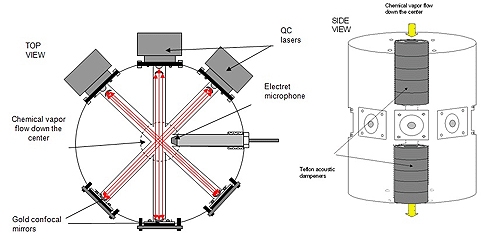The new system is said to be based on the photoacoustic effect, in which the absorption of light by materials generates characteristic acoustic waves. By using a laser and very sensitive microphones — in a technique called laser photoacoustic spectroscopy (LPAS) — vanishingly low concentrations of gases, at parts per billion, can be detected.
According to a statement, the drawback with traditional LPAS systems is that they only identify one chemical at a time.
‘Photoacoustics is an excellent analytic tool, but is somewhat limited in the sense that one traditionally only measures one absorption parameter at a time,’ said Kristan Gurton, an experimental physicist at the US Army Research Laboratory (ARL) in Adelphi, Maryland. ‘As I started looking into the chemical/biological detection problem, it became apparent that multiple LPAS absorption measurements — representing an “absorption spectrum” — might provide the added information required in any detection and identification scheme.’
To create such a multi-wavelength LPAS system, Gurton, along with Melvin Felton and Richard Tober of the ARL, designed a photoacoustic cell. This hollow, cylindrical device holds the gas being sampled and contains microphones that can listen for the characteristic signal when light is applied to the sample.
In this experiment, the researchers used a specialised cell that allows different gases to flow through the device for testing. As the vapour of five nerve agent mimics was flowed in, three laser beams, each modulated at a different frequency in the acoustic range, were propagated through the cell.
‘A portion of the laser power is absorbed, usually via molecular transitions, and this absorption results in localised heating of the gas,’ Gurton said.
Molecular transitions occur when the electrons in a molecule are excited from one energy level to a higher energy level.
‘Since gas dissipates thermal energy fairly quickly, the modulated laser results in a rapid heat/cooling cycle that produces a faint acoustic wave,’ which is picked up by the microphone. Each laser in the system will produce a single tone, so, for example, six laser sources have six possible tones. ‘Different agents will affect the relative “loudness” of each tone, so for one gas, some tones will be louder than others, and it is these differences that allow for species identification.’

The signals produced by each laser were separated using multiple ‘lock-in’ amplifiers — which can extract signals from noisy environments — each tuned for a specific laser frequency. Then, by comparing the results with a database of absorption information for a range of chemical species, the system identified each of the five gases.
Because it is optically based, the method allows for instant identification of agents, as long as the signal-to-noise ratio, which depends on laser power and the concentration of the compound being measured, is sufficiently high, and the material in question is in the database.
Before a device based on the technique could be used in the field, Gurton said, a quantum cascade (QC) laser array with at least six ‘well-chosen’ mid-infrared (MidIR) laser wavelengths would need to be available.
Once such laser arrays are available, the method ultimately could be tailored for a variety of detection scenarios ranging from the obvious need to protect soldiers during conflict to civilian applications such as detecting the presence of harmful chemical gases that are difficult to detect with conventional techniques.
A sufficiently rugged device for in-the-field use, he envisions, could be about the size of a milk carton. ‘A photoacoustic cell is surprisingly simple and inexpensive to produce, with all of the cost and size driven primarily by the packaging of the quantum cascade laser array,’ he adds.
A paper describing the system has been published in the Optical Society’s (OSA) journal Optics Letters.





Nanogenerator consumes CO2 to generate electricity
Nice to see my my views being backed up by no less a figure than Sabine Hossenfelder https://youtu.be/QoJzs4fA4fo